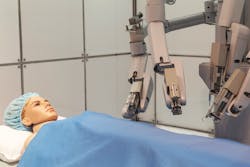5 Things You Need to Know about the Motion-Control System Market
Motion control is an engineering technology that encompasses several industries. As explained by the Allied Motion Company, a motion-control system is any that involves moving parts in a controlled manner and the majority of the technology covered under mechanical engineering is the design and implementation of these motion-control systems. Here are five things you need to know about motion control.
Motion-control systems are part of our everyday lives and comprise some of the most crucial systems like transportation, medical, and robotics.
1. Motion control is part of your daily life—whether you realize it or not.
Motors and gears can be found everywhere in our society. If you live in a city, there are motion-control systems like dc gear motors that operate mass-transit trains and buses, operate your elevators, and even the coffee machine in your office. In a suburban environment, you have motion-control systems in your cars and escalators in shopping malls.
For the industrial space, motion-control systems are being used to automate processes. More companies are turning to robotics and conveyor systems to achieve higher efficiency margins in assembly and production.
2. By 2022, the motion control market will be a $22.84 billion industry.
According to MarketsandMarkets research report, the motion-control market in 2015 was valued at $15.65 billion. This value will increase to $22.84 billion by 2022. The main driver will be metal and machinery manufacturing, as industry leaders look to improve speed and accuracy along with increased productions. Other drivers will be maximizing the assembly of products and the ac motor market.
The use of motion-control systems in medicine will rise as robots and microscopic medical equipment become more commonplace.
3. Robotics is the next wave of motion systems.
The robot market is poised to reach $23.90 billion by 2022, according to MarketsandMarkets research report, mostly due to the use of robots in industrial settings. Robots are being installed into warehouses to handle material movement and handling carts. Companies like Amazon are looking to increase the role of robots in their warehouses to assist human operators with product delivery. Robots are being used as well in more delicate operations like surgical robots and service robots. Along with these, robots that can enter high-risk situations will help the market grow during the forecast period of 2016 to 2022.
4. The medical industry is fueled by motion control systems.
The medical industry has specific requirements for their applications, especially the ability to achieve precise control. The use of motion systems in medicine includes bionic prosthetics, wheelchairs that can traverse stairs and rough terrain, air pumps for respiratory needs, and transplanted mechanical valves. In the world of biomedical engineering, the Bureau of Labor Statistics expects the number of jobs to rise to 27,600 by 2018. A large portion of these jobs will be in developing medical devices that are small, efficient, and use motion-control systems to operate.
In 2016, the linear motion system was already on an upward trend especially in areas of robots, material handling, and machine tools. This market will continue to grow to $22.84 billion USD by 2022. (Source: TechNavio)
5. The motion system is essential for automotive, aerospace, and defense.
Mobile weapon systems, pilot cooling system pumps, and an aircraft emergency fuel system are a few examples of how motion-control systems are used in aerospace. Motion-control systems are used in hazardous environments and designed to strict military standards to ensure operation. Secondary flight-control systems that control flaps, speed brakes, and trim use actuators for example to achieve their desired operations.
The automotive world will also see an increase of motion control use as we approach an increase in electric and autonomous vehicles. The market for electric cars will be $731 billion market by 2027, and the autonomous vehicle industry is also set to become a $127 billion industry by 2027.
The robotics industry will continue to rise as part of the motion-control movement, especially in warehouses and material-handling facilities. (Image courtesy of Rollon)
Here is a list of other fields that will have a great impact on the motion-control industry.
- Aerospace and defense
- Automotive
- Semiconductor and electronics
- Metal and machinery manufacturing
- Food and beverages
- Medical
- Printing and paper
- Furniture and wood
- Plastic and rubber
- Energy
- Textile
- Oil and gas




